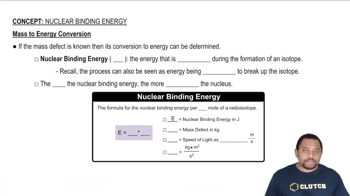Here are the essential concepts you must grasp in order to answer the question correctly.
Beta Emission
Beta emission is a type of radioactive decay in which a beta particle, which is an electron or positron, is emitted from an atomic nucleus. In this process, a neutron is transformed into a proton, increasing the atomic number of the element by one while the mass number remains unchanged. This transformation alters the identity of the element, leading to the formation of a new element.
Recommended video:
Nuclear Equations
Nuclear equations are symbolic representations of nuclear reactions that show the initial and final states of the particles involved. They typically include the atomic number and mass number of the isotopes, allowing for the conservation of mass and charge. In a balanced nuclear equation, the sum of the atomic numbers and mass numbers on both sides must be equal, reflecting the conservation laws in nuclear processes.
Recommended video:
Isotopes
Isotopes are variants of a particular chemical element that have the same number of protons but different numbers of neutrons, resulting in different mass numbers. For example, rubidium-90 is an isotope of rubidium with 37 protons and 53 neutrons. Understanding isotopes is crucial for writing balanced nuclear equations, as the specific isotope undergoing decay determines the products formed during the reaction.
Recommended video:
 Verified step by step guidance
Verified step by step guidance


